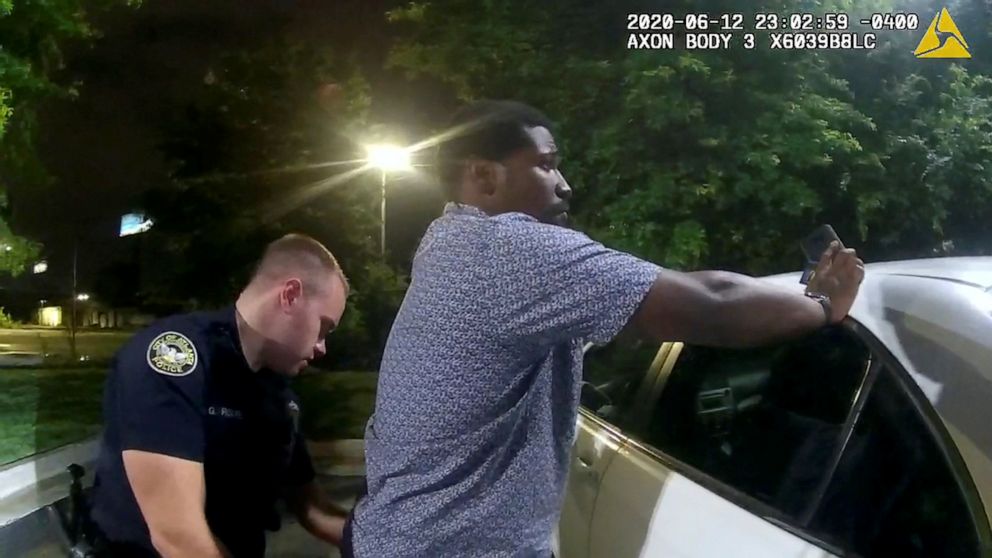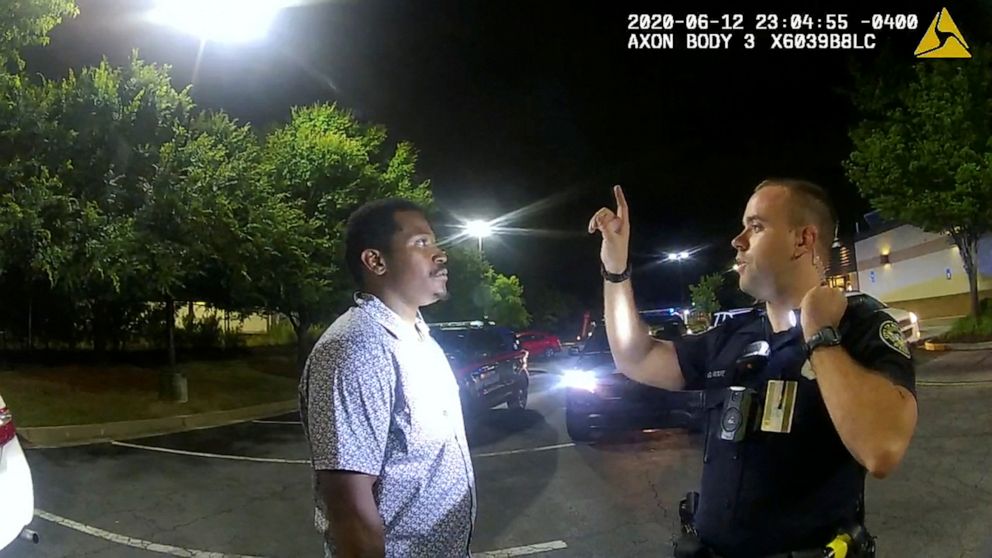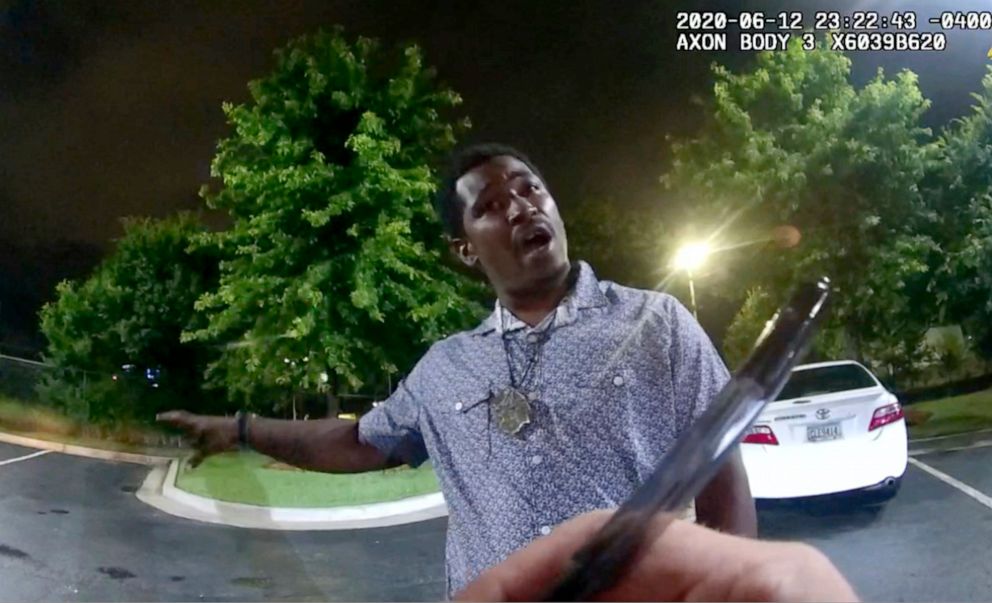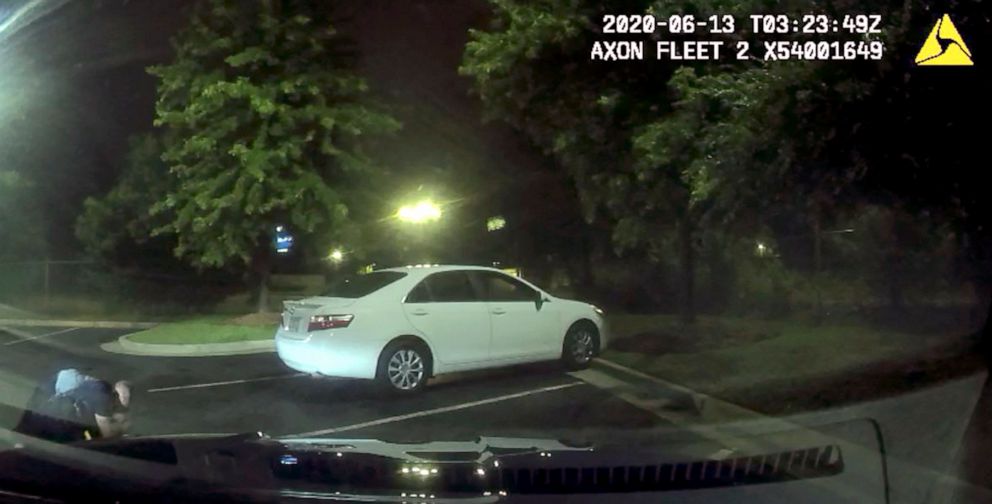Rayshard Brooks went from telling Atlanta officer about visiting mother's grave to being fatally shot: Video
Before being shot to death by an Atlanta police officer in the parking lot of a fast food restaurant, Rayshard Brooks had a cordial conversation about being in the area to visit his mother's grave and to celebrate one of his young daughter's birthdays, according to a series of videos released by officials.
The shooting of Brooks, who is black, on Friday night sparked new protests and an arson fire at the Wendy's where the confrontation started and escalated into the use of lethal force. It came on the heels of days of protests in Atlanta and across the nation over the officer-involved killing of George Floyd in Minneapolis.
Initial autopsy results released Sunday evening by the Fulton County Medical Examiner said that Brooks died from two gunshot wounds to his back that "created organ injuries and blood loss," and that the manner of death was a homicide.
The fatal episode led to the resignation of Atlanta Police Chief Erika Shields on Saturday, the firing of the officer who shot and killed Brooks and the other officer involved being yanked from the streets and placed on administrative leave.

The encounter unfolded about 10:30 p.m. when officers David Brosnan and Garret Rolfe responded to a call from a Wendy's employee that a man was passed out in his car in the restaurant's drive-thru and was blocking customers.
Brosnan was the first officer to arrive. His body camera captured him knocking several times on the driver's window of a white Toyota rental car, trying to awaken the driver. Unable to get the attention of the driver, later identified as Brooks, 27, Brosnan opened the driver's side door and shook Brooks to wake him up.
“Yo, what’s up my man?” Brosnan asked Brooks. "You good, you don’t need an ambulance or something like that? You just tired?"
Brosnan then told Brooks to move his car and take a nap. But when the officer went back to his patrol car, Brooks apparently fell back to sleep, prompting Brosnan to return to the Toyota and wake him again.
Brooks then drove his car a short distance to a parking space.

The body camera records Brosnan going back to his patrol vehicle a second time, saying to himself, "Do I want to deal with this dude right now?"
He then goes over to where Brooks parked and questions him about his groggy condition.
"How much did you have to drink tonight?" Brosnan asked Brooks.
Brooks responded, "Not much" and then says he had one drink.
Brosnan asked Brooks for his driver's license and then radioed a dispatcher that he needed a DUI certified officer to respond to the scene.
As Brosnan and Brooks waited, the two men spoke to each other genially.
"You here for a visit?" Brosnan asked.
Brooks answered, "I'm visiting." When asked who he was visiting, he said, "My mother's gravesite."
"I'm sorry to hear that," Brosnan said. "How long has she been passed for."
Brooks answered, "It's been probably about a year and a half now. Her birthday's just passed..."

When Rolfe arrived at the scene, Brosnan went to speak to him and told him that he found Brooks passed out behind the wheel in the drive-thru line.
"It took me a few minutes to wake him up. I kept knocking, opened the door, shook him. Woke up super groggy, kind of smelt ... pretty good smell of alcohol beverage coming out of the car. Eyes are watery and glassy. ... He wasn't sure where he was and he's telling me he had one drink earlier."
Rolfe then went to speak to Brooks. In the conversation recorded by Rolfe's body camera, Brooks said he didn't remember being asleep in the Wendy's drive-thru line.
When asked if he knew where he was, Brooks stated a location in neighboring Clayton County off the Old Dixie Highway about 10 miles away.
Rolfe eventually asked Brooks to take a series of field sobriety tests, asking him to follow his index finger with his eyes and walk a straight line heel to toe.
At one point Brooks asked the officers to let him go, saying, "I can just go home. My daughters are there right now. My daughter’s birthday was yesterday. "
But Rolfe asked Brooks if he would take a Breathalyzer test.
"I don’t want to refuse anything," Brooks said calmly.
Rolfe is seen administering the Breathalyzer, which according to the video, registered a blood-alcohol level of .108%, or slightly above the legal limit of .08%.
"Alright, I think you've had too much drinks to be driving so can you put your hands behind your back for me," Rolfe ordered Brooks.
Until Rolfe began to handcuff him, Brooks was friendly and respectful of both officers, even referring to the officer who would soon take his life as "Mr. Rolfe."
But as soon as Rolfe and Brosnan begin to make the arrests, Brooks, without warning, began to struggle and within moments he is seen wrestling with both officers on the ground.
"Stop fighting, stop fighting," one of the officers yelled.
A police dashboard camera video showed Brosnan drawing his yellow stun gun and threatening, "You're going to get tased, your going to get tased" and aiming the device at Brooks' legs.
Brooks, according to the video, responded, "Mr. Rolfe, come on, man." He is then seen grabbing hold of Brosnan's stun gun.
"Hands off the Taser, hands off the Taser," Brosnan yelled.

But Brooks managed to wrestle the stun gun from Brosnan's hands. He scrambled to his feet and ran out of the view of the patrol car camera. Rolfe is seen aiming what appears to be his yellow stun gun and fires, apparently missing Brooks.
Rolfe's body camera apparently dislodged and fell to the ground during the struggle but continued to record, capturing three gunshots.
Surveillance video taken from the Wendy's showed Brooks running through the parking lot with Rolfe and Brosnan behind him. At one point, Brooks turned and allegedly shot the stun gun at Rolfe who drew his service weapon from his holster and opened fire. The video showed Brooks falling to the ground, and the officers converging on him.
L. Chris Stewart, an attorney for Brooks' family, denounced the shooting as an unnecessary use of deadly force and during a news conference on Saturday night said Rolfe could have resorted to less-lethal force to take Brooks into custody.
"I've had cases where officers have used Tasers ... and they argue with us that Tasers are not deadly," Stewart said. "You can't say he ran off with a weapon that could kill somebody when you say it's not deadly."
Just hours after the shooting, Shields, who had been police chief since 2016, submitted her resignation to Atlanta Mayor Keisha Lance Bottoms.
After viewing the videos of the incident that resulted in Brooks' death, Bottoms demanded that Rolfe be terminated from the police force
"I firmly believe that there is a clear distinction between what you can do and what you should do," Bottoms said in a press conference regarding the officer's actions. "I do not believe this was a justified use of deadly force and have called for the immediate termination of the officer."
Brosnan was placed on administrative leave as the Georgia Bureau of Investigation (GBI) and the Fulton County District Attorney's Office launched probes of the shooting.
"How many times do we have to endure this?" Fulton County District Attorney Paul Howard Jr. told ABC News of his reaction of hearing another black person had been shot by a police officer. "And so when I saw that, that it was almost with disbelief that, first of all, it was happening in our country, but also that it was happening here in Atlanta."
He said his office immediately started putting together a separate independent investigation of the incident, adding that "justice to me looks like following the facts."
"Following the facts, we are going to be examining and reexamining the evidence," Howard said. "We've got a couple of things that we have to confirm with our state investigators, the GBI. And once we confirm those things sometime during this week, we are going to make a decision and we are going to announce it to the public."
He said whether charges will be filed will come down to one "critical question."
"That critical question came at the very instance of the shooting," Howard said. "So what we have to decide, based upon the prevailing law in this country and in our state, is ... at the time that shot was fired, whether or not it was done to save the life of that officer."
This report was featured in the Monday, June 15, 2020, episode of “Start Here,” ABC News’ daily news podcast.
"Start Here" offers a straightforward look at the day's top stories in 20 minutes. Listen for free every weekday on Apple Podcasts, Google Podcasts, Spotify, the ABC News app or wherever you get your podcasts.



